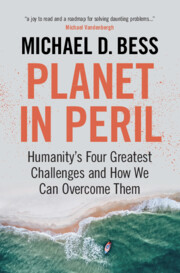Book contents
- Planet in Peril
- Reviews
- Planet in Peril
- Copyright page
- Dedication
- Epigraph
- Contents
- Fictional Vignettes
- Acknowledgements
- 1 Introduction
- Part I Existential Threats: The Four Most Pressing Dangers Facing Humankind
- Part II Strategies and Obstacles: The Solutions We Need, and What’s Preventing Them from Being Realized
- Part III Sensible Steps for Today’s World: Powerful Measures We Can Implement Right Away
- Part IV The Middle-Term Goal: New International Tools for the Late Twenty-First Century
- 14 A Promising Track Record: The Dramatic Growth of International Institutions and Networks Since 1900
- 15 How to Escape the Sovereignty Trap: Lessons and Limitations of the European Union Model
- 16 Taking the United Nations Up a Notch: Planet-Level Solutions for the Year 2100
- 17 The Other Path to 2100: Ruthless Competition, Fingers Crossed
- Part V The Long-Term Goal: Envisioning a Mature System of Global Governance for the Twenty-Second Century
- Endnotes
- Bibliography
- Index
14 - A Promising Track Record: The Dramatic Growth of International Institutions and Networks Since 1900
from Part IV - The Middle-Term Goal: New International Tools for the Late Twenty-First Century
Published online by Cambridge University Press: 13 October 2022
- Planet in Peril
- Reviews
- Planet in Peril
- Copyright page
- Dedication
- Epigraph
- Contents
- Fictional Vignettes
- Acknowledgements
- 1 Introduction
- Part I Existential Threats: The Four Most Pressing Dangers Facing Humankind
- Part II Strategies and Obstacles: The Solutions We Need, and What’s Preventing Them from Being Realized
- Part III Sensible Steps for Today’s World: Powerful Measures We Can Implement Right Away
- Part IV The Middle-Term Goal: New International Tools for the Late Twenty-First Century
- 14 A Promising Track Record: The Dramatic Growth of International Institutions and Networks Since 1900
- 15 How to Escape the Sovereignty Trap: Lessons and Limitations of the European Union Model
- 16 Taking the United Nations Up a Notch: Planet-Level Solutions for the Year 2100
- 17 The Other Path to 2100: Ruthless Competition, Fingers Crossed
- Part V The Long-Term Goal: Envisioning a Mature System of Global Governance for the Twenty-Second Century
- Endnotes
- Bibliography
- Index
Summary
This chapter surveys the rapid growth of globe-spanning organizations and institutions over the past 120 years – from the League of Nations to the UN to today’s International Criminal Court and European Union. Spurred by the world wars, economic crises, and environmental disasters of the twentieth century, humanity has already come much farther than most people realize in building innovative instruments of global concertation and crisis management. Therefore, the pathways of constructive change that lie ahead of us can best be understood as continuations and extensions of the remarkable gains already achieved. Four institutions – OECD, UN, NATO, and EU – exemplify distinct levels of rising integration across national boundaries. Institutions such as International Non-Governmental Organizations (INGOs) have offered powerful new pathways for citizens’ concerted action beyond borders. The recently-adopted UN doctrine of Responsibility to Protect (R2P) reflects a newfound legitimacy of cross-border ethical obligations and proactive interventions to halt large-scale humanitarian disasters.
Keywords
- Type
- Chapter
- Information
- Planet in PerilHumanity's Four Greatest Challenges and How We Can Overcome Them, pp. 199 - 211Publisher: Cambridge University PressPrint publication year: 2022



